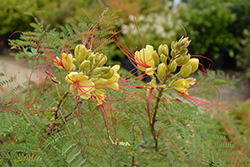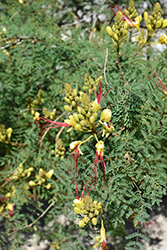It's all about ...
plants

Bird of Paradise Shrub
Caesalpinia gilliesii
Height: 10 feet
Spread: 6 feet
Sunlight:
![]()
Hardiness Zone: 8b
Other Names: Desert Bird of Paradise, syn. Poinciana gilliesii
Description:
This interesting shrub produces spectacular upright racemes of luminous yellow and red blooms that are long lasting; graceful foliage creates a wonderful texture; perfect for patio containers, or near walkways
Ornamental Features
Bird of Paradise Shrub features showy racemes of yellow flowers with red anthers rising above the foliage from early to mid summer, which emerge from distinctive chartreuse flower buds. Its attractive tiny oval bipinnately compound leaves emerge light green in spring, turning bluish-green in colour the rest of the year. The fruits are showy tan pods displayed from early fall to early winter.
Landscape Attributes
Bird of Paradise Shrub is an open multi-stemmed evergreen perennial with an upright spreading habit of growth. It brings an extremely fine and delicate texture to the garden composition and should be used to full effect.
This is a relatively low maintenance plant, and should only be pruned after flowering to avoid removing any of the current season's flowers. It is a good choice for attracting bees, butterflies and hummingbirds to your yard, but is not particularly attractive to deer who tend to leave it alone in favor of tastier treats. Gardeners should be aware of the following characteristic(s) that may warrant special consideration;
- Invasive
Bird of Paradise Shrub is recommended for the following landscape applications;
- Mass Planting
- Hedges/Screening
- General Garden Use
- Naturalizing And Woodland Gardens
- Container Planting
Planting & Growing
Bird of Paradise Shrub will grow to be about 10 feet tall at maturity, with a spread of 6 feet. It has a low canopy with a typical clearance of 1 foot from the ground. Although it is technically a woody plant, this fast-growing plant can be expected to behave as a perennial in our climate if planted outdoors over the winter, usually regrowing from its base (crown) the following year. As such, gardeners should take into consideration that it will perform differently than it would in its native habitat.
This plant should only be grown in full sunlight. It prefers dry to average moisture levels with very well-drained soil, and will often die in standing water. It is considered to be drought-tolerant, and thus makes an ideal choice for a low-water garden or xeriscape application. It is not particular as to soil type or pH. It is somewhat tolerant of urban pollution. This species is not originally from North America.
Bird of Paradise Shrub is a fine choice for the garden, but it is also a good selection for planting in outdoor pots and containers. Its large size and upright habit of growth lend it for use as a solitary accent, or in a composition surrounded by smaller plants around the base and those that spill over the edges. It is even sizeable enough that it can be grown alone in a suitable container. Note that when growing plants in outdoor containers and baskets, they may require more frequent waterings than they would in the yard or garden. Be aware that in our climate, most plants cannot be expected to survive the winter if left in containers outdoors, and this plant is no exception. Contact our experts for more information on how to protect it over the winter months.
This plant is not reliably hardy in our region, and certain restrictions may apply; contact the store for more information.

